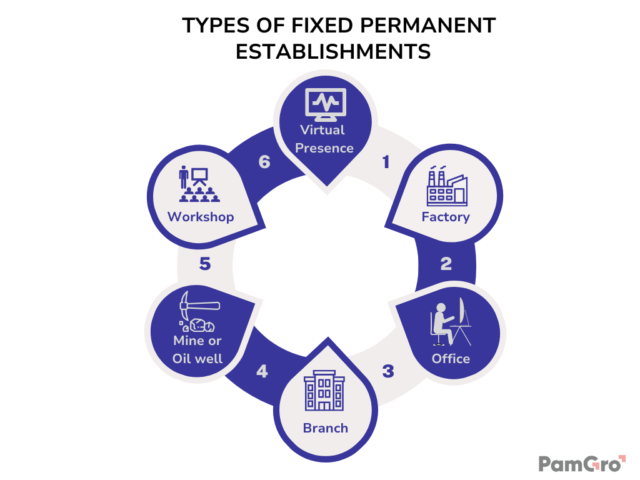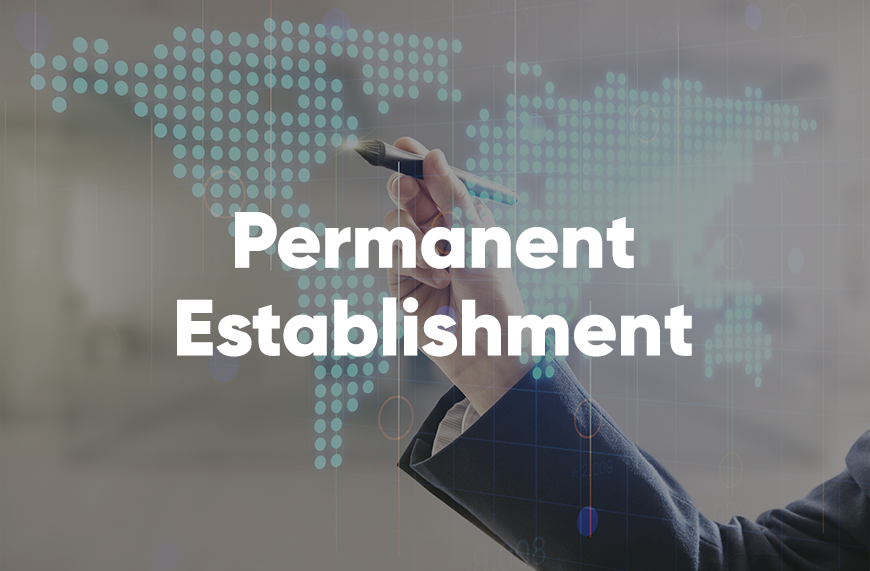TABLE OF CONTENTS
- What is Permanent Establishment?
- How Do Permanent Establishments Work?
- Types of Permanent Establishments
- Criteria for Establishing a Permanent Establishment
- Tax Implications of Permanent Establishment
- Mitigating Permanent Establishment Risk
- Recent Trends and Developments
- Protect Your Business with a Employer Of Record
- Conclusion
“Permanent establishment” (P.E.) is crucial in the complex world of international taxation. It determines whether a foreign company has a taxable presence in another country. Understanding P.E.s is vital for businesses operating across borders to manage tax liabilities and comply with local regulations.
This article explores the types of P.E.s, their various business permanent establishment, tax implications, strategies to mitigate risks, and recent trends.
What is Permanent Establishment?
A permanent establishment (PE) occurs when a business has a stable presence in a country outside its home base, making it liable for local taxes. Under most income tax treaties, a PE in another contracting state is subject to tax under the source country’s normal income tax rules, and this taxation may also extend to income not attributable to the PE. This concept is vital for businesses operating internationally, as it determines tax obligations in each country. Ignoring PE rules can lead to unpaid taxes and legal issues.
Permanent Establishments, also known as the “substance requirement,” refers to a foreign enterprise’s business, with an ongoing presence in a country. Indicators of sufficient establishment can subject the company to local tax rates. Companies often try to avoid creating a PE to prevent additional corporate taxes and compliance burdens. Understanding and managing PE risks is crucial for successful international operations.
How Do Permanent Establishments Work?
A permanent establishment (PE) occurs when your corporation maintains a fixed location in another country and generates revenue there. Here’s a straightforward breakdown of how it works
1. Fixed Location and Revenue Generation:
- If your business has an ongoing, stable presence in a foreign country and earns income there, it qualifies as a PE.
- This means your company will be subject to the local taxes imposed by that jurisdiction.
- However, certain actions or situations, such as preparatory or auxiliary activities, will not trigger permanent establishment status.
2. Tax Treaties
- Various tax treaties exist between your home country and the host country to define tax rates and obligations.
- These treaties are designed to prevent your company from being taxed twice on the same income.
3. Registration and Indirect Taxes
- Corporations with a PE in a foreign country must typically register with local authorities.
- They often pay indirect taxes such as goods and services tax (GST) or value-added tax (VAT), which are levied on products or services sold for consumption or use.
By understanding how permanent establishments work, businesses can better navigate the complexities of international taxation and compliance.
Types of Permanent Establishments
The Organisation for Economic Co-operation and Development (OECD) defines P.E.s, which most countries follow.
A building or construction site can be considered a permanent establishment if it exists for more than a specified duration, typically one year or twelve months, according to Article 5(3) of the OECD Model Convention. There are mainly three types of PE and they are
1. Fixed Place of Business (FPOB)
This is a physical location where a foreign company conducts business activities.
Examples include offices, factories, workshops, mines, and oil wells.
For an FPOB to be considered a P.E., it must fullfil certain factors.
- Physical: A tangible location.
- Fixed: Permanent and not temporary.
- Controlled by the enterprise: The company must have control over the location.
- Durable: Usually existing for at least six months.
- Active in business: The company must conduct business activities there.

Examples:
- An American software company opens a development office in Australia to work on local projects. This office is equipped with computers, and staff regularly work there, making it a Fixed Place of Business PE.
- A finance company from Canada sets up an office in Germany. This office operates continuously and is crucial for the company’s operations, classifying it as a PE.
2. Dependent Agent PE
This type of permanent establishment (P.E.) is created when a person or entity (agent) in a foreign country regularly has the power to sign agreements on behalf of a company from another country. This means the agent can make binding decisions for the foreign company by entering into contracts.
Key factors include:
- Authority to Contract: The agent can bind the company in contracts.
- Habitual Exercise: The agent regularly uses this authority.
- Dependence: The agent relies on the foreign company for business.
Examples:
- A sales representative in Poland who is authorized to finalize sales contracts for a Japanese electronics company establishes a Dependent Agent PE.
- An independent marketing firm in Paris promoting products for a foreign company without contract-signing authority would not be considered a P.E.
- Additionally, there’s the concept of “Service PE”, which arises when a foreign company provides services in another country for a specific period, often exceeding 183 days in 12 months.
3. Selling services PE
If you regularly service clients in other foreign countries, your company could be considered a “permanent establishment” (PE) there. This means you might owe taxes in that foreign country, on top of your home country taxes.
Examples of businesses that could create a PE.
- Think IT firms
- Consultants
- Overseas financial advisors
The key takeaway? Be aware of PE rules to avoid double taxation and keep your international business growing smoothly!
Criteria for Establishing a Permanent Establishment
Tax authorities look at several key factors to determine if a permanent establishment (P.E.) exists. Here are the main points they consider:
- Physical Presence:
- Location: There must be a physical place, like an office, factory, or warehouse, that the foreign company controls and uses for business.
- Use: The place should be used for regular business activities, not just for storage or temporary tasks.
2. Duration of Presence:
- Period: The business needs to be in the host country for a significant amount of time, usually more than six months.
- Consistency: Continuous and regular operations increase the likelihood of having a PE.
3. Employee Activities:
- Role of Employees: Employees performing core business tasks, such as sales or production, are crucial in establishing a P.E.
- Authority: Employees with the power to make crucial decisions and sign contracts strengthen the case for a PE.
4. Agent’s Authority:
- Contract Authority: If an agent in the host country can regularly sign contracts for the foreign company, this can create a dependent agent PE.
- Dependence: The agent should be economically dependent on the foreign company.
5. Nature of Business Activities:
- Core vs. Support Activities: Core activities like manufacturing or direct sales are more likely to create a P.E., unlike support activities such as storing goods or collecting information.
- Significant Operations: Substantial and ongoing business activities in the host country increase the chance of having a PE.
6. Presence of Equipment:
- Machinery and Equipment: Having machinery or equipment in the host country can contribute to establishing a P.E.
- Infrastructure: The presence of infrastructure, like servers, can also be considered.
7. Service Provision:
- Service PE: If a foreign company provides services in the host country through its employees for more than 183 days within a year, it might create a service P.E.
- Type of Services: The nature and duration of the services provided are essential factors.
8. Legal and Economic Dependence:
- Contracts: The relationship between the foreign company and its agents or branches in the host country is examined. If the local entity relies heavily on the foreign company, it can lead to a P.E.
- Integration: The more integrated the local operations are with the foreign company, the more likely it is to be considered a P.E.
Example
A U.S. software company sets up an office in Germany with a sales team that signs contracts and an I.T. team providing customer support. The office has operated for over a year. Here’s how tax authorities might view this:
- The office provides a fixed business location.
- Operating for over a year shows a long-term presence.
- Sales team signing contracts strengthens the case for a P.E.
- I.T. team providing continuous services adds to the likelihood of a service P.E.
In this case, the U.S. company would likely have a P.E. in Germany, making it subject to German tax laws for the profits made there.
Understanding these criteria helps businesses manage their international operations and avoid unexpected tax obligations.
Customer Success Story
Discover how Pamgro’s Expertise helped a recruiting company for a seamless cross-border expansion across the UK and Netherlands.
Tax Implications of Permanent Establishment
Having a P.E. in a foreign country brings several other income tax treaties and obligations:
1. Corporate Income Tax:
The foreign company’s profits attributable to the P.E. are taxable in the host country, which can lead to double taxation if the home country also taxes the same profits.
Example:
A US-based company’s profits from a P.E. in Germany will be taxed in Germany and potentially in the U.S. as well.
2. Registration Requirements:
The company might need to register for tax purposes in the host country.
Example:
A Canadian company with a P.E. in Brazil must register with Brazilian tax authorities.
3. Payroll Taxes:
Employees working through the P.E. could be subject to host country payroll taxes.
Example:
Employees of an Indian company working at a P.E. in the U.K. would be subject to U.K. payroll taxes, including income tax and national insurance contributions.
Mitigating Permanent Establishment Risk
Businesses can use various strategies to manage P.E. risk:
1. Limiting Physical Presence:
Setting up a representative office with limited functions might be preferable to a full operational setup.
Example:
A representative office that only conducts market research or liaison activities might avoid creating a PE.
2. Managing Agent Activity:
Define the scope of an independent agent‘s authority carefully and ensure they operate independently to avoid creating a dependent agent PE.
Example:
An agent in Spain tasked with only promoting products, without the authority to finalize sales contracts, reduces the risk of establishing a PE.
3. Structuring Activities:
Conduct business activities outside the host country, such as using digital channels or by purchasing goods from local fulfilment centres.
Example:
A company selling products online to customers in France and using a local third-party logistics provider for delivery might need to establish a PE.
4. Employer of Record (EoR) Services:
An EoR legally employs workers on behalf of another business, helping avoid creating a P.E. by employing local staff through the EoR.
Example:
A US company using an EoR service in Japan to employ local staff can avoid P.E. risk as the EoR is the legal employer.
5. Tax Planning and Documentation:
Proactive planning and meticulous documentation are essential for tax return. Consult with tax professionals to navigate P.E. complexities and minimize tax liabilities.
Example:
Regular consultations with international tax advisors to review business activities, documentation of transactions, and precise records of employee roles and the nature of physical business presence in host countries.
Recent Trends and Developments
The international tax landscape is constantly evolving:
- Increased Scrutiny of Digital Businesses:
Tax authorities are paying more attention to digital businesses and exploring ways to tax them, including the concept of a “digital P.E.”
Example:
A global streaming service with significant user engagement in a country may face tax scrutiny to determine if a digital P.E. exists.
- OECD Model Tax Convention Updates:
The OECD periodically updates its Model Tax Convention, which impacts bilateral tax treaties. Staying informed about these updates is crucial.
Example:
Recent updates might include new guidelines on digital taxation or clarifications on service P.E.s that businesses must adhere to.
- Remote Work and P.E.s:
The rise of remote work due to COVID-19 has complicated the P.E. landscape. The OECD has clarified that temporary remote work won’t create P.E.s, but the long-term effects remain to be seen.
Example:
A company with employees working remotely from different countries needs to evaluate the potential P.E. risks if remote work becomes a permanent arrangement.
Protect Your Business with a Employer Of Record
EOR or employer of record is a third party firm that handles your cross-order work paying barely to sometimes no attention at all. An EOR acts as a local entity instead of you having to face all this complications by yourself. EOR’s take care of all things employment which includes but is not limited to payroll, benefits, onboarding, and more.
At PamGro, we specialize in simplifying global expansion. As your trusted Employer of Record (EOR) partner, we take care of all the intricate details such as immigration, background checks, onboarding, payroll, and legal compliance. By entrusting these responsibilities to us, you can fully concentrate on your core business activities and seamlessly navigate the path to international growth.
Conclusion
Understanding permanent establishments is crucial for businesses going global. By recognizing the types of P.E.s, the criteria for their establishment, tax implications, and mitigation strategies, companies can better navigate international taxation.
Consulting with tax professionals is highly recommended for managing these complexities. Keeping abreast of recent trends and developments ensures compliance and helps optimize tax efficiency for global operations.
Payroll Solutions Unrivalled since 15 Years







